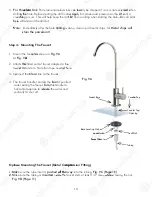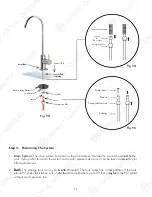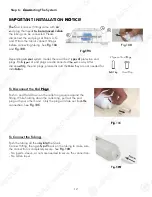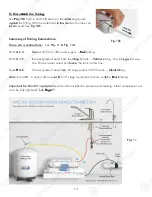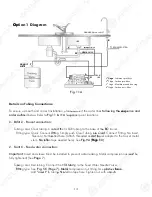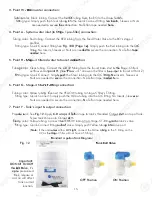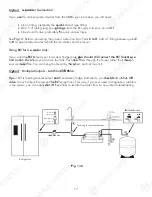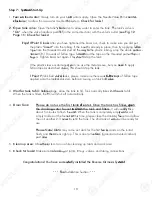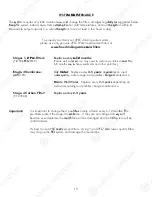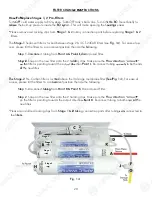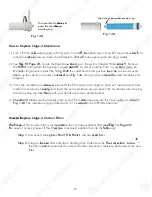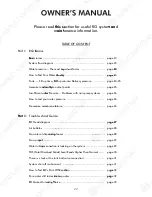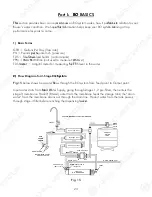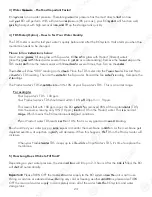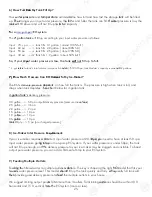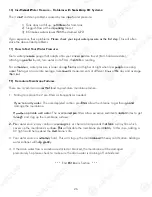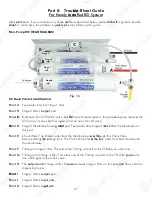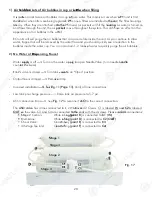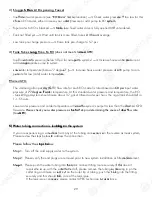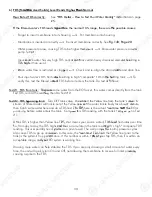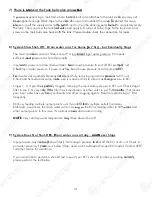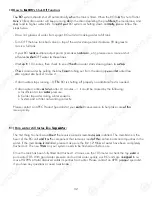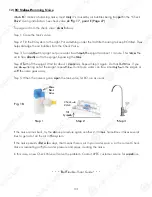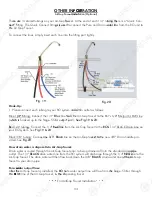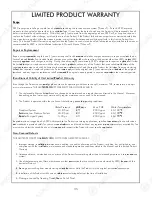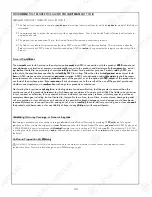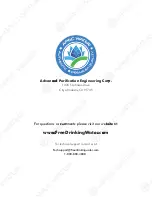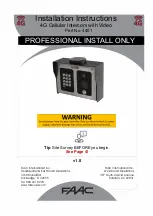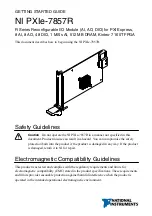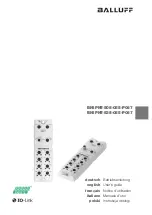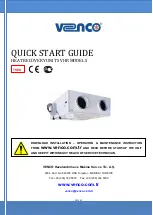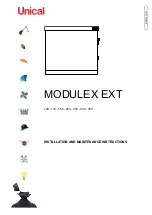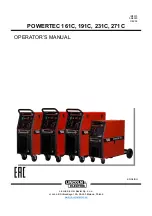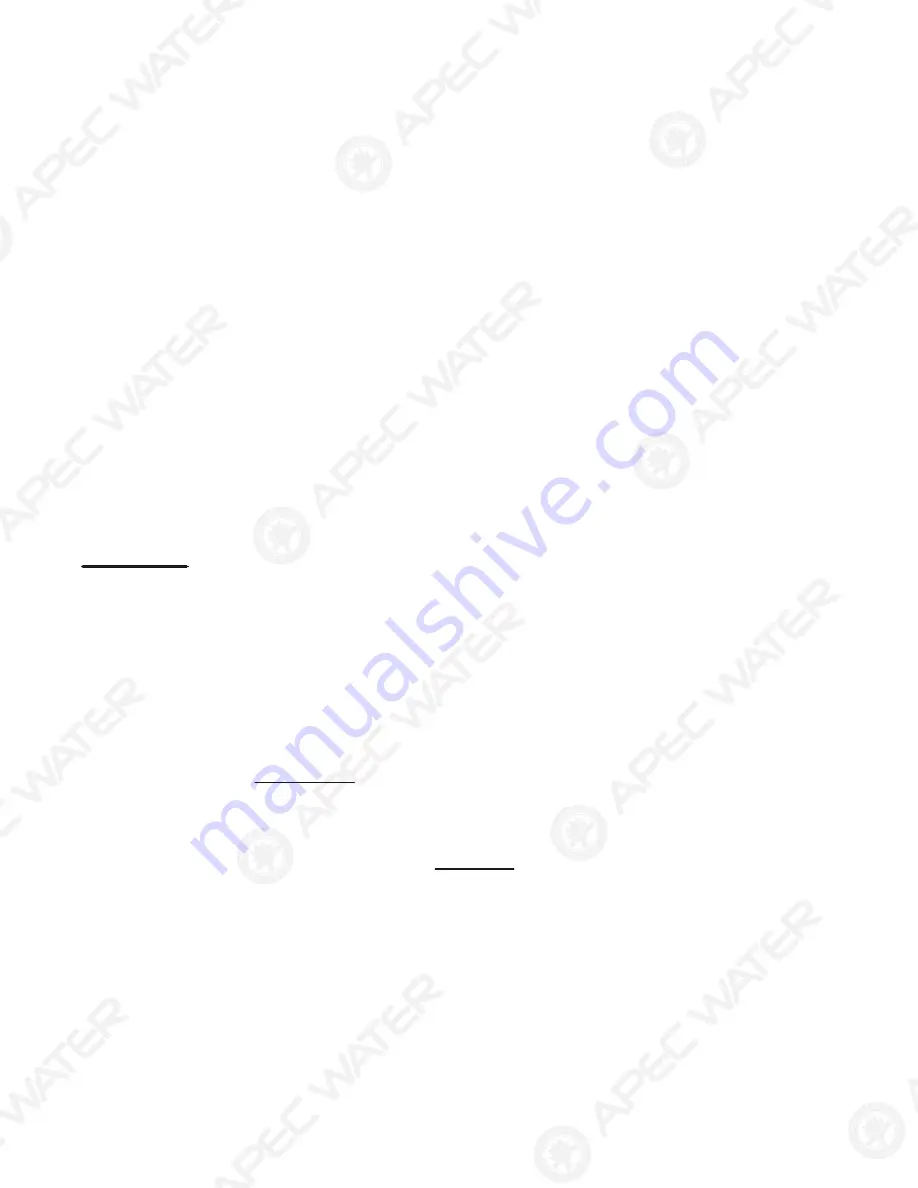
24
3) Water Pressure – The Most Important Factor!
RO systems run on water pressure. Therefore your water pressure has the most direct effect on how
well your RO will perform. With sufficient water pressure (85 psi max.), your RO system will function well,
give high output with high removal rate, and fill up the storage tank quickly.
4) TDS Meter (Option) – How to Test Your Water Quality:
The TDS meter is used to test your water’s quality before and after the RO system. It also tells you when the
membrane needs to be changed.
Please follow instructions below:
Use 2 clean glasses, fill one glass with Tap water, fill the other glass with Product (filtered) water
(rinse this glass with filtered water several times to get an accurate reading). Remove the Sensor cap on the
TDS meter and rinse the meter sensor with filtered water several times, then Turn on the meter.
The meter will show “000” reading on its screen. Place the TDS meter into the Product water. Record Prod-
uct water’s TDS reading. Then do the same for the Tap water. Record the Tap water’s reading. Compare the
2 readings.
The Product water’s TDS should be about 3%-10% of your Tap water’s TDS. This is a normal range.
For example:
Your Tap water’s TDS: 100 ppm
Your Product water’s TDS should read within: 10% of 100ppm => 10ppm
This means that with 100 ppm input, the RO system has removed 90% of the contaminants (TDS)
from the source, leaving only 10% (10 ppm) residual TDS in the Product water. This is a normal
range. Which means the RO membrane is in good condition.
If your Product water TDS reads less than 10%, that is a very good and normal reading.
You should test your water once or twice a year to monitor the membrane condition. As the membrane gets
depleted overtime, its rejection capacity will decrease. When this happens, the TDS in the Product water will
increase.
When your Product water TDS creeps up to 15%- 20% of input water’s TDS, it’s time to replace the
membrane.
5) How Long Does It Take to Fill Tank?
Depending on your water pressure, the standard tank will fill up in 2-3 hours. After the tank is filled, the RO
will shut off automatically.
Important!
Please TURN OFF the main cold water supply to the RO system when the unit is not in use
during a vacation or extended leave. During very cold or freezing weather conditions, please also TURN
OFF the main cold water supply and completely drain all of the water from the RO system and water
storage tank.
24
3) Water Pr
Pr
es
essu
sure
r
– The Most Important Factor!
RO sys
ys
te
ms
ms run on water pressure. Therefore yo
yo
ur
ur w
water pressure has the most direc
ec
t effe
e
ct
ct
on how
well
y
you
u
r
r
RO will perform. With sufficient water
er
p
p
ressure (85 psi max.), your RO
s
sys
yste
tem
m
wi
i
ll function well,
gi
gi
ve
ve
h
hi
igh output with high removal rat
t
e,
e, a
a
nd
nd
fil
ll
l up the storage tank quickly.
4) TDS Meter (Option) – How to Test Your Water Quality:
The TDS meter is used to test your water’s quality before and after the RO system. It also tells you when th
h
e
e
membrane needs to be changed.
Please follow inst
stru
ru
ct
ctio
i
ns below:
Use 2 clean gl
g
as
as
se
se
s,
s,
fill one glass with Tap water, fill the
he
o
o
th
the
er glass with Product (filtered) water
r
(rinse this gl
gl
as
as
s
s
wi
wi
th
th
filtered water several times to get
et
a
an
n
ac
curate reading). Remove the Sens
ns
or
or c
c
a
ap on the
TDS mete
e
r
r an
an
d
d
ri
nse the meter sensor with filtered
ed w
wat
ate
er several times, then Turn on the m
m
et
eter
er.
The
e
me
te
ter will show “000” reading on its s
s
cr
cr
ee
ee
n.
n.
Place the TDS meter into the Pr
Pr
od
od
uct
t w
water. Record Prod-
uc
ct
t wa
wat
ter’s TDS reading. Then do the s
s
am
am
e
e
fo
fo
r the Tap water. Record the Tap
wa
wa
te
ter’
r’
s
s
reading. Compare the
2
2
re
re
adings.
The Product water’s TDS sh
ou
ould
ld
b
b
e
a
about 3%-10% of your Tap water’s TDS. This is a normal range.
For example:
p
Your Tap water’s TDS: 100 ppm
Your Product water’s TDS should read within: 10% o
o
f
f
10
1
0ppm => 10ppm
This means that with 100 ppm input, the RO s
s
ys
yste
te
m
m
h
has removed 90% of the contami
i
na
nant
nts
s
(
(TDS)
from the source, leaving only 10% (10 ppm)
m) r
res
es
id
id
ual TDS in the Product water. This
s
i
i
s
s
a
a normal
ra
ra
ng
ng
e.
e
Which means the RO membrane is
s
in
in g
good condition.
If
If
your Product water TDS reads less
ss t
than 10%, that is a very good and nor
or
ma
ma
l
l re
reading.
Yo
Yo
u should test your water once or twi
wi
ce
ce
a
a
year to monitor the membrane co
co
nd
ndit
ition. As the membrane gets
depleted overtime, its rejection cap
apac
acit
it
y will decrease. When this happe
p
ns,
th
th
e
e
T
TDS in the Product water will
increase.
When your Produc
c
t
t
wa
wa
te
ter
r TDS creeps up to 15%- 20% of inp
ut
ut
w
water’s TDS, it’s time to replace the
membrane.
5) How Long Does It Take to Fill Tank?
Depending on your water pressure, the standard
rd t
tan
an
k will fill up in 2-3 hours. After the tan
nk
k
is
is f
filled, the RO
will shu
hut
t off automatically.
Im
Impo
po
rtant!
Please TURN OFF the mai
in
n co
cold
ld water supply to the RO system whe
he
n
n th
th
e
unit is not in use
du
during a vacation or extended leav
v
e.
e. D
D
u
uring very cold or freezing weather co
cond
nd
it
itio
io
ns, please also TURN
OFF the main cold water supply
ly a
and
d
c
ompletely drain all of the water fro
o
m
m th
the
e
RO system and water
storage tank.
Summary of Contents for Ultimate RO-QUICK90
Page 2: ......

